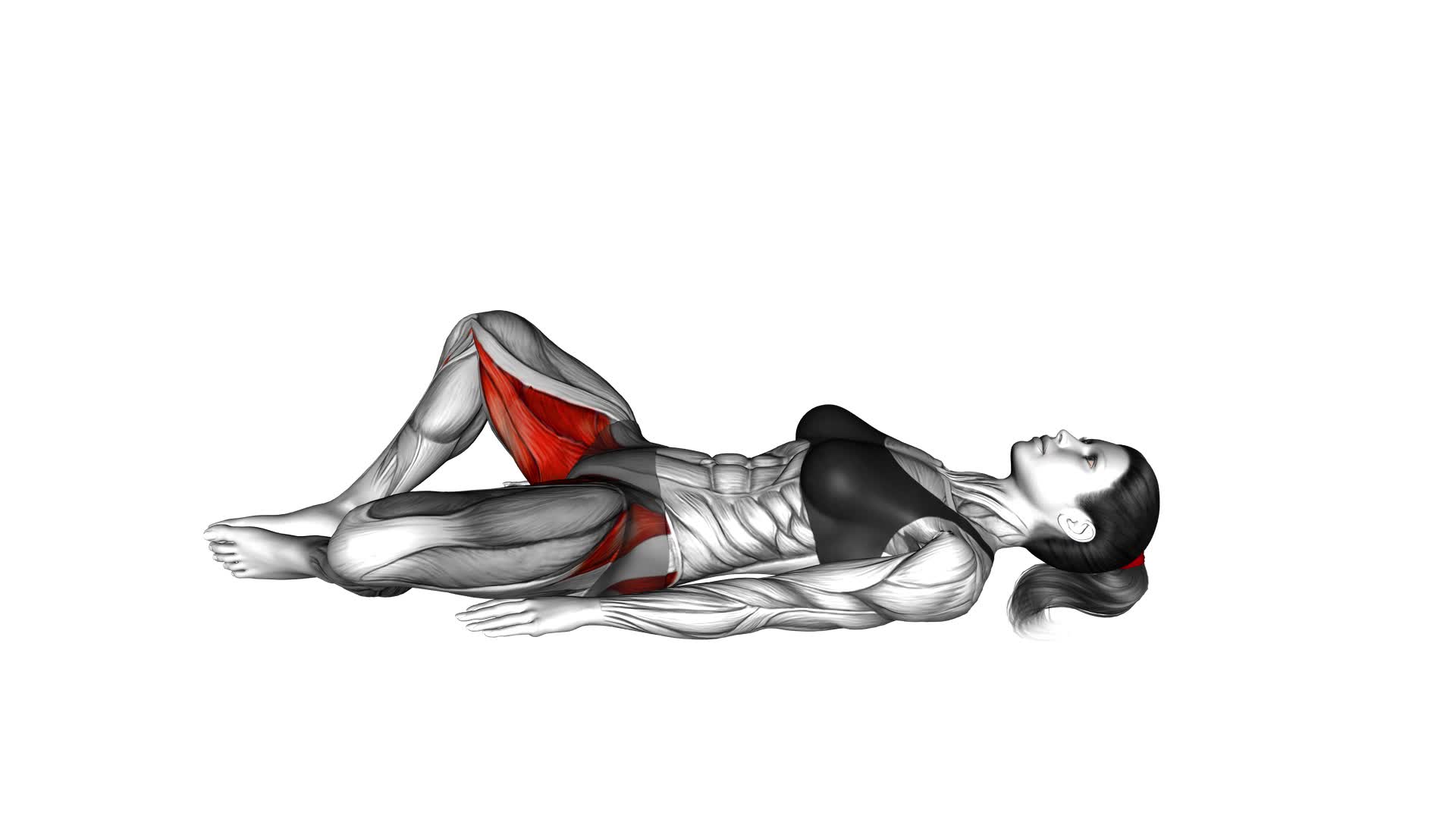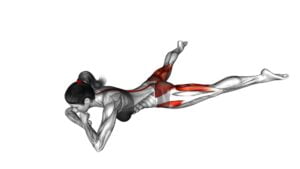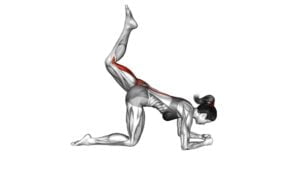Pulsing Adduction and Abduction (female) – Video Exercise Guide & Tips

Get ready to tone and strengthen your muscles with pulsing adduction and abduction exercises! This video exercise guide is specifically designed for females, providing a step-by-step demonstration and helpful tips.
Watch This Exercise Video
You'll learn the proper form and technique for these exercises, as well as modifications and progressions to challenge yourself. Avoid common mistakes and maximize your results with this effective workout.
Let's get started!
Key Takeaways
- Pulsing adduction and abduction exercises target inner and outer thigh muscles for strength and toning.
- These exercises can improve muscle definition and overall leg strength.
- They also enhance hip stability and flexibility.
- Pulsing adduction and abduction exercises can increase calorie burn and potential weight loss.
Benefits of Pulsing Adduction and Abduction Exercises
Discover the remarkable benefits you can achieve by incorporating pulsing adduction and abduction exercises into your fitness routine. These exercises specifically target your inner and outer thigh muscles, helping to strengthen and tone them. By regularly engaging in pulsing adduction and abduction exercises, you can expect to see improved muscle definition and overall leg strength.
One of the major benefits of these exercises is that they can be done without any special equipment. If you don't have access to a gym or exercise machines, you can still perform pulsing adduction and abduction exercises using your own body weight. This makes them a convenient and accessible option for anyone looking to work their thigh muscles.
In addition to toning your thighs, pulsing adduction and abduction exercises also help to improve hip stability and flexibility. By engaging these muscles, you can enhance your overall balance and reduce the risk of injury during physical activities.
Incorporating pulsing adduction and abduction exercises into your fitness routine can also have a positive impact on your overall body composition. These exercises engage multiple muscle groups simultaneously, leading to increased calorie burn and potential weight loss.
Equipment Needed for Pulsing Adduction and Abduction
To perform pulsing adduction and abduction exercises, there are a few pieces of necessary equipment.
You'll need a resistance band or cable machine to provide the necessary tension for the exercises.
Alternatives to these equipment include using household items such as water bottles or cans as weights.
Necessary Equipment for Pulsing Adduction and Abduction
You will need a few pieces of equipment for pulsing adduction and abduction exercises. First, it's recommended to use resistance bands or cables to add resistance to your movements. These will help to strengthen and tone your inner and outer thighs.
Additionally, using ankle weights can provide an extra challenge and increase the intensity of your workout. When selecting resistance bands or cables, choose a level of resistance that's challenging but still allows you to maintain proper form throughout the exercise.
Safety considerations are also important when performing pulsing adduction and abduction exercises. Make sure to choose a sturdy and stable surface to perform the exercises on, and always listen to your body and stop if you experience any pain or discomfort.
Alternatives to Required Equipment?
For pulsing adduction and abduction exercises, you can use alternative equipment options to achieve similar results. If you don't have access to the required equipment, don't worry! There are several bodyweight exercises and household items that you can use instead.
Here are some alternatives to consider:
- Bodyweight squats: Squats are a great way to target your lower body muscles without any equipment. Focus on squeezing your glutes and engaging your inner thighs as you perform the exercise.
- Resistance bands: If you have resistance bands at home, you can use them to add extra resistance to your adduction and abduction movements. Secure the band around your ankles and perform the exercises as usual.
- Water bottles: Fill up two water bottles and hold them in your hands as you perform the exercises. The added weight will increase the intensity of your workout.
- Towel: Place a towel between your knees and squeeze it as you perform the adduction exercise. This will engage your inner thigh muscles effectively.
- Step or sturdy chair: Use a step or a sturdy chair to elevate one leg and perform the abduction exercise. This will challenge your muscles and add an extra element of difficulty to the exercise.
Proper Form and Technique for Pulsing Adduction and Abduction
Achieve proper form and technique for pulsing adduction and abduction by focusing on controlled movements and engaging your inner thigh and hip muscles. Pulsing adduction and abduction exercises offer numerous benefits, including strengthening and toning your inner thighs, glutes, and hips. To maximize these benefits, it's essential to perform the exercises with correct form.
When performing pulsing adduction and abduction, common mistakes to avoid include using momentum instead of controlled movements. It's crucial to engage your inner thigh and hip muscles throughout the exercise, rather than relying solely on the momentum of your legs. Another common mistake is using excessive weight, which can lead to improper form and increase the risk of injury. Start with a lighter weight or resistance band and gradually increase as your strength improves.
To achieve proper form, start by standing with your feet shoulder-width apart and your knees slightly bent. Engage your core muscles and maintain a neutral spine throughout the exercise. For pulsing adduction, bring one leg out to the side, keeping it straight, and pulse it up and down in a controlled manner. For pulsing abduction, bring one leg in towards the midline of your body, keeping it straight, and pulse it up and down.
By focusing on controlled movements and engaging the appropriate muscles, you can ensure proper form and technique for pulsing adduction and abduction exercises.
Now, let's move on to the next section, where we'll discuss modifications and progressions for these exercises.
Modifications and Progressions for Pulsing Adduction and Abduction
To modify and progress your pulsing adduction and abduction exercises, consider incorporating variations that target different muscle groups and increase the intensity of your workout. Here are some modifications and progressions you can try:
- Resistance Bands: Attach a resistance band around your thighs or ankles to add resistance and challenge your muscles further.
- Weighted Ankles: Wear ankle weights to increase the resistance and intensity of your pulsing adduction and abduction exercises.
- Elevated Surface: Place your feet on an elevated surface like a step or bench to increase the range of motion and engage your muscles differently.
- Single-Leg Variation: Perform the pulsing adduction and abduction exercises on one leg at a time to challenge your balance and stability while targeting the muscles in a different way.
- Combination Exercises: Combine pulsing adduction and abduction movements with other exercises, such as squats or lunges, to work multiple muscle groups simultaneously and create a more dynamic workout.
Common Mistakes to Avoid During Pulsing Adduction and Abduction
One common mistake to avoid during pulsing adduction and abduction exercises is rushing through the movements without proper form and control. It's important to maintain a slow and controlled pace to fully engage the target muscles and prevent injury.
Another common mistake is using too much weight or resistance, which can compromise form and lead to strain or muscle imbalances. It's recommended to start with lighter weights or resistance bands and gradually increase as your strength and technique improve.
Additionally, improper alignment and positioning can hinder the effectiveness of the exercise. Make sure to keep your spine neutral and engage your core throughout the movements. Avoid leaning forward or backward, as this can put strain on the lower back and diminish the benefits of the exercise.
Lastly, it's crucial to listen to your body and not push through pain or discomfort. If you experience any pain, modify the exercise or seek guidance from a qualified fitness professional.
Tips for Maximizing Results With Pulsing Adduction and Abduction
To maximize your results with pulsing adduction and abduction, it's important to consistently challenge yourself while maintaining proper form and control. Here are some technique tips to help you achieve the best possible results:
- Start with proper alignment: Stand tall with your feet hip-width apart and engage your core muscles. This will ensure that you're in a stable position throughout the exercise.
- Focus on the squeeze: When performing the pulsing adduction and abduction movements, make sure to squeeze your inner and outer thigh muscles. This will help to activate and strengthen these muscle groups.
- Gradually increase the intensity: As you become more comfortable with the exercise, gradually increase the intensity by adding resistance. This can be done by using resistance bands or ankle weights.
- Maintain a consistent pace: To maximize the benefits of pulsing adduction and abduction, maintain a consistent pace throughout the exercise. This will keep your muscles engaged and prevent them from getting too fatigued.
- Incorporate variety: To challenge your muscles in different ways, try incorporating different variations of the pulsing adduction and abduction exercise. This can include changing the tempo, range of motion, or adding dynamic movements.
Frequently Asked Questions
Can Pulsing Adduction and Abduction Exercises Help Reduce Cellulite?
Pulsing adduction and abduction exercises can potentially help reduce cellulite. These exercises target the inner and outer thighs, strengthening and toning the muscles in those areas. By doing so, it may improve the appearance of cellulite.
However, it's important to note that cellulite reduction is a complex process and can't be solely achieved through exercise. Factors like diet, hydration, and genetics also play a role.
Always consult with a healthcare professional before starting any new exercise routine, especially if you have postpartum recovery, knee or hip injuries.
How Often Should I Perform Pulsing Adduction and Abduction Exercises to See Results?
To see results from pulsing adduction and abduction exercises for toning, it's important to be consistent with your frequency. Aim to perform these exercises at least three times a week. This will allow your muscles to be challenged and gradually become stronger over time.
However, it's crucial to listen to your body and give yourself rest days in between workouts. Remember, consistency is key to achieving the desired results.
Can Pulsing Adduction and Abduction Exercises Help With Postpartum Recovery?
Pulsing adduction and abduction exercises can be beneficial for postpartum recovery. These exercises help improve postpartum fitness and strengthen the pelvic floor muscles.
By incorporating pulsing adduction and abduction into your workout routine, you can target the muscles that are often weakened during pregnancy and childbirth. The pulsing motion helps increase muscle activation and can aid in restoring strength and stability in the pelvic area.
Consistency is key, so aim to perform these exercises regularly for best results.
Are There Any Specific Warm-Up Exercises I Should Do Before Starting Pulsing Adduction and Abduction Exercises?
Before starting pulsing adduction and abduction exercises, it's important to do warm-up exercises. Warm-up exercises help prepare your muscles and joints for the workout ahead, reducing the risk of injury. They also increase blood flow and body temperature, which can improve your overall performance during the exercise.
Incorporating dynamic stretches, such as leg swings or hip circles, can be beneficial for warming up the muscles involved in adduction and abduction movements.
Can Pulsing Adduction and Abduction Exercises Be Beneficial for Individuals With Knee or Hip Injuries?
Pulsing adduction and abduction exercises can be beneficial for individuals with knee or hip injuries. These exercises help to strengthen the muscles surrounding the knees and hips, providing stability and support.
However, it's important to modify the exercises to suit your specific needs and limitations. Consult with a healthcare professional or a qualified instructor to learn the proper modifications and ensure you're performing the exercises correctly to avoid further injury.
Conclusion
In conclusion, pulsing adduction and abduction exercises offer numerous benefits for women looking to strengthen their hip muscles.
By using the proper equipment and maintaining correct form and technique, these exercises can be modified and progressed to suit individual fitness levels.
Avoiding common mistakes and following tips for maximizing results will help women achieve their desired outcomes.
Incorporating pulsing adduction and abduction into a well-rounded exercise routine can contribute to overall strength and stability in the hips.

Author
Years ago, the spark of my life’s passion ignited in my mind the moment I stepped into the local gym for the first time. The inaugural bead of perspiration, the initial endeavor, the very first surge of endorphins, and a sense of pride that washed over me post-workout marked the beginning of my deep-seated interest in strength sports, fitness, and sports nutrition. This very curiosity blossomed rapidly into a profound fascination, propelling me to earn a Master’s degree in Physical Education from the Academy of Physical Education in Krakow, followed by a Sports Manager diploma from the Jagiellonian University. My journey of growth led me to gain more specialized qualifications, such as being a certified personal trainer with a focus on sports dietetics, a lifeguard, and an instructor for wellness and corrective gymnastics. Theoretical knowledge paired seamlessly with practical experience, reinforcing my belief that the transformation of individuals under my guidance was also a reflection of my personal growth. This belief holds true even today. Each day, I strive to push the boundaries and explore new realms. These realms gently elevate me to greater heights. The unique combination of passion for my field and the continuous quest for growth fuels my drive to break new ground.







